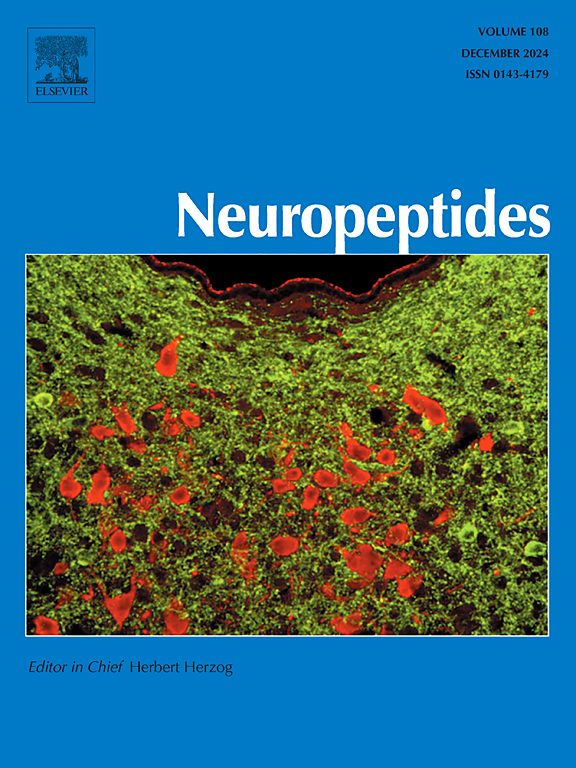Catestatin attenuates cerebral ischemia/reperfusion injury and suppresses endoplasmic reticulum stress
IF 2.7
3区 医学
Q3 ENDOCRINOLOGY & METABOLISM
引用次数: 0
Abstract
Ischemic stroke is one of the leading causes of death worldwide. Catestatin (CST), as a pleiotropic hormone, displays an anti-apoptotic effect, in addition to its known roles in cardiovascular regulation. However, the role of CST in ischemic stroke remains unclear. In this study, we investigated the temporal changes of CST levels in the cortex and serum of middle cerebral artery occlusion/reperfusion (MCAO/R) rats. Intracerebroventricular administration of CST significantly alleviated neurological deficits, reduced cerebral infarct volume, cerebral edema, and pathological damage, while attenuating neuronal apoptosis and modulating apoptosis-related proteins. Notably, CST suppressed endoplasmic reticulum stress (ERS) by inhibiting the PERK pathway. Furthermore, in vitro experiments using the oxygen-glucose deprivation/reperfusion (OGD/R) model of PC12 cells demonstrated that CST similarly inhibited apoptosis, as evidenced by flow cytometry and consistent changes in apoptosis-related proteins. These findings collectively demonstrate that CST exerts neuroprotective effects against cerebral ischemia-reperfusion injury (CIRI), with these effects potentially mediated through inhibition of ERS via the PERK signaling pathway.
Catestatin减轻脑缺血/再灌注损伤和抑制内质网应激
缺血性中风是世界范围内死亡的主要原因之一。Catestatin (CST)作为一种多效性激素,除了已知的心血管调节作用外,还具有抗凋亡作用。然而,CST在缺血性卒中中的作用尚不清楚。本研究观察了大脑中动脉闭塞/再灌注(MCAO/R)大鼠皮层和血清中CST水平的变化。脑室内给药CST可显著减轻神经功能缺损,减少脑梗死体积、脑水肿和病理损伤,同时减轻神经元凋亡和调节凋亡相关蛋白。值得注意的是,CST通过抑制PERK途径抑制内质网应激(ERS)。此外,体外氧-葡萄糖剥夺/再灌注(OGD/R)模型实验表明,CST对PC12细胞的凋亡具有相似的抑制作用,流式细胞术和凋亡相关蛋白的一致变化证明了这一点。这些发现共同表明,CST对脑缺血再灌注损伤(CIRI)具有神经保护作用,这些作用可能是通过PERK信号通路抑制ERS介导的。
本文章由计算机程序翻译,如有差异,请以英文原文为准。
求助全文
约1分钟内获得全文
求助全文
来源期刊

Neuropeptides
医学-内分泌学与代谢
CiteScore
5.40
自引率
6.90%
发文量
55
审稿时长
>12 weeks
期刊介绍:
The aim of Neuropeptides is the rapid publication of original research and review articles, dealing with the structure, distribution, actions and functions of peptides in the central and peripheral nervous systems. The explosion of research activity in this field has led to the identification of numerous naturally occurring endogenous peptides which act as neurotransmitters, neuromodulators, or trophic factors, to mediate nervous system functions. Increasing numbers of non-peptide ligands of neuropeptide receptors have been developed, which act as agonists or antagonists in peptidergic systems.
The journal provides a unique opportunity of integrating the many disciplines involved in all neuropeptide research. The journal publishes articles on all aspects of the neuropeptide field, with particular emphasis on gene regulation of peptide expression, peptide receptor subtypes, transgenic and knockout mice with mutations in genes for neuropeptides and peptide receptors, neuroanatomy, physiology, behaviour, neurotrophic factors, preclinical drug evaluation, clinical studies, and clinical trials.
 求助内容:
求助内容: 应助结果提醒方式:
应助结果提醒方式:


